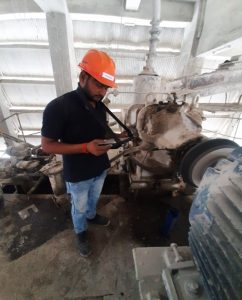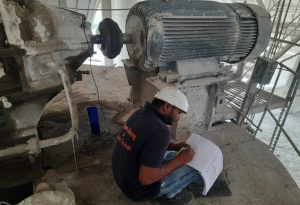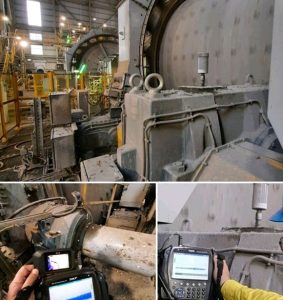Vibration Analysis & Vibration Monitoring
Vibration Analysis and Vibration Monitoring
Vibration analysis is a process of looking for anomalies and monitoring change from the established vibration signature of a system. The vibration of any object in motion is characterized by variations of amplitude, intensity, and frequency. These vibration signatures can be correlated to physical phenomena, making it possible to use vibration data to gain insights into the health of equipment. Vibration analysis can be used to:
Find a developing problem that can be repaired to increase machine lifetime.
Detect and monitor a chronic problem that cannot be repaired and will only get worse.
Establish acceptance testing criteria to ensure that installation/repairs are properly conducted.
Vibration Monitoring of Motor :
Motors will likely experience high vibration levels at some point during their lifetime. Performing predictive maintenance through motor vibration monitoring can prevent issues resulting from a variety of motor faults, including those often found in motor bearings, gearboxes and rotors.

Bearings Condition Monitoring :
Bearing defects are often the source of vibration in machinery, but bearing condition monitoring can help keep identify these defects and determine when repairs or replacements are needed. Bearing defects can include excessive loads, true or false brinelling, over heating, reverse loading, normal fatigue failure, corrosion, loose or tight fits, and misalignment, among other potential problems.
Gearbox Vibration Monitoring :
Another application for machine condition monitoring includes gearbox vibration monitoring. In gearboxes, impacting and friction can occur, and a single crack in a gear could cause a slight change in speed once the defective teeth are inside of the load zone. This will result in impacting, and if there is insufficient lubrication for the gear teeth, friction will also occur. Machine vibration monitoring can detect these instances of impacting and friction in predictive maintenance.
Rotor Vibration Monitoring :
There are several causes of lateral vibrations in rotors, including instability and unbalance, along with other types of forces impacting the rotor. Cracks are often formed, frequently leading to reduced natural frequencies as a result of reduced rigidness. Rotor vibration analysis can monitor the rotor’s behavior to help locate a developed crack.

How is Vibration Analysis Conducted?
Although a number of sophisticated techniques can be used, the two most fundamental methods for presenting vibration data are the time waveform (amplitude as a function of time) and the frequency spectrum (amplitude as a function of frequency).
Convert signal to Digital :
Vibration data is captured by accelerometers installed on one or more orthogonal axes. The sampling rate of the accelerometers needs to be fast enough to capture the behavior of interest. Next, the signal needs to be digitized at an appropriate sampling rate to enable it to be digitally reconstructed. The result is the time waveform (oscillation amplitude as a function of time) of vibration along the axes of interest.
Look at Harmonics :
The correlation process starts with looking at so-called synchronous peaks – peaks that are harmonics of the fundamental rotational frequency of the shaft. Consider an 1800 RPM, 3 Hz motor that is driven by a 480 V, 60 Hz electrical input. The fundamental frequency would be 30 Hz. Any synchronous beats – peaks at 2X, 3X, 4X, etc. – provide insights about issues directly related to the rotation of the motor shaft.
Consider a six-vane pump. A pump with six vanes, for example, will have a vibration spike at 6X, or six times the fundamental frequency. If that peak triples or quadruples, it indicates some sort of problem with the vanes.
Time-Waveform Analysis :
Time-waveform analysis can enhance machine vibration analysis. It should not be considered a primary tool, but rather as a tool to provide additional insights. It can be useful for low-speed applications because it reveals the way the machine is moving. Time-waveform analysis is frequently used for analyzing gears, for example. There is a crossover point at around 100 RPM – below that speed, time-waveform analysis provides better results and frequency analysis is not effective.

Phase Analysis :
The other tool that complements frequency and time-waveform analysis is phase analysis. This is an analysis of the heavy spot of the analysis in relation to some trigger. This might be vibration introduced by anything that correlates with the shaft rotation frequency, such as a bearing defect. Phase analysis makes it possible to determine where the shaft vibration occurs in relation to the shaft.
What to Look In Vibration Analysis?
The features in vibration spectra can be separated into steady-state signals, which repeat continuously and transient signals, which occur as a result of specific events. Signal characteristics can be further subdivided into synchronous, asynchronous, and sub synchronous features as follows:
Synchronous Vibration Peaks :
In rotating equipment, the vibration spectrum will feature a spike at the fundamental rotation frequency of the shaft. This is true for any system, not just one with flaws. The system typically will also display spikes at multiples of the fundamental frequency, referred to as 2X, 3X, etc. These are known as synchronous peaks. They are frequently tied to physical characteristics of the system. A gear with 32 teeth will introduce a vibration spike at 32X, or 32 times the fundamental frequency, for example.
A synchronous Vibration Peaks :
Not all features in a vibration spectrum are synchronous. The system may suffer periodic shocks or impacts that will generate spikes. Asynchronous frequency spikes also can be generated by features like a gearbox with multiple stages, a pump suffering from cavitation, etc. These asynchronous peaks can provide useful diagnostic information.
Sub-Synchronous Peaks :
Vibration spectra can exhibit a third type of feature known as sub synchronous peaks. These are basically harmonics of the fundamental frequency. They are caused by any physical element of the system that operates at a frequency below that of the main shaft. A loose belt on an axis rotating at 30 Hz, for example, might slip enough to move at just 29.19 Hz. This will create a frequency spike immediately next to the fundamental spike at 30 Hz. Other examples include cage defects in ball bearings, turbulence, etc.
What Can Vibration Detect?
The tools and methods described above can be applied to quantitatively assess the condition and performance of equipment. Vibration data can reveal when equipment has broken welds or bolts, whether the rotor bars in a motor are intact, if the air gap between rotor and stator in the motor is non-concentric, etc. Vibration data can alert maintenance teams to structural or rotating looseness or the presence of resonance.
Vibration analysis also can be used to determine how well a machine is assembled. It can detect misalignment in a pump, for example, determining whether the rotating elements are binding, if the base is uneven, or if torsion exists between motor and pump.
The Best Asset Classes for Vibration Monitoring Programs :
There are several types of asset classes that are ideal for vibration monitoring programs. Typically, machinery that’s more prone to damage requiring lengthy, expensive, or challenging repairs is ideal for vibratory monitoring, along with equipment that’s critical to production, suffers frequent damages, and requires frequent evaluation to determine reliability. Common equipment types include:
Trouble shooting monitoring of Assets :
Many plants operate around the clock, stopping once a month or once a quarter for scheduled maintenance. Unscheduled downtime reduces productivity and can cost from tens of thousands of dollars per hour to tens of thousands of dollars per minute. Online vibration monitoring provides a method for monitoring a troubled asset during the run-up to planned maintenance. If the condition of the equipment worsens, the line can be stopped before catastrophic failure occurs. With continuous online vibration monitoring, maintenance teams can receive immediate alerts when the condition of a troubled asset changes, enabling rapid response.
